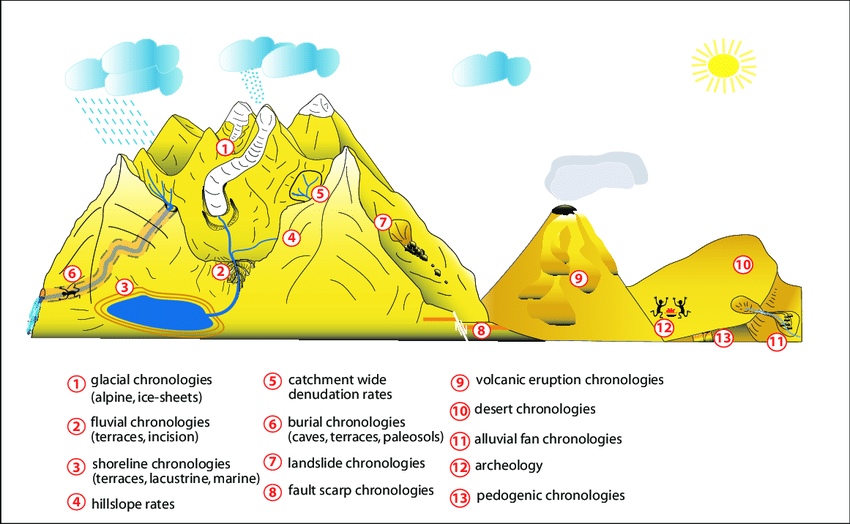@WFS,World Fossil Society,Riffin T Sajeev,Russel T Sajeev
Surface exposure dating with cosmogenic nuclides
SUSAN IVY-OCHS & FLORIAN KOBER
Eiszeitalter und Gegenwart Quaternary Science Journal,57/1–2,157–189,Hannover 2008
Abstract: In the last decades surface exposure dating using cosmogenic nuclides has emerged as a powerful
tool in Quaternary geochronology and landscape evolution studies. Cosmogenic nuclides are produced in
rocks and sediment due to reactions induced by cosmic rays. Landforms ranging in age from a few hundred
years to tens of millions of years can be dated (depending on rock or landform weathering rates) by measuring nuclide concentrations. In this paper the history and theory of surface exposure dating are reviewed
followed by an extensive outline of the fields of application of the method. Sampling strategies as well as
information on individual nuclides are discussed in detail. The power of cosmogenic nuclide methods lies in
the number of nuclides available (the radionuclides 10Be, 14C, 26Al, and 36Cl and the stable noble gases 3
He and 21Ne), which allows almost every mineral and hence almost every lithology to be analyzed. As a result
focus can shift to the geomorphic questions. It is important that obtained exposure ages are carefully scrutinized in the framework of detailed field studies, including local terrace or moraine stratigraphy and regional
morphostratigraphic relationships; as well as in light of independent age constraints.

Schematic diagram showing the various landforms that can be dated and approaches for using cosmogenic nuclides to address questions of timing and rates of landscape change (see also BIERMAN & NICHOLS 2004).
Summary and outlook
The ability to use cosmogenic nuclides to determine how long minerals have been exposed at the surface of the earth provides an unrivaled tool for determining ages of landforms and rates of geomorphic processes. Depending or rock and landform weathering rates, landforms ranging in age from a few hundred years to tens of millions of years can be dated. Because of this unique capability, the variety of applications of cosmogenic nuclides will continue to grow. Concern about methodological uncertainties, such as those associated with the production rates, the site latitude and
altitude scaling factors, as well as the effect of past changes in the Earth’s magnetic field, has led to the establishment of an international consortium made up of CRONUS-Earth (www.physics.purdue.edu/cronus) and CRONUS-EU (www.cronus-eu.net).
Analysis of artificial targets and samples from natural sites with independent age control are underway to refine production rates. Scaling factors are being evaluated with neutron monitors and analysis of same age natural samples taken along altitudinal transects (for example lava flows). Numerical modeling is being used to
constrain production rates and scaling factors both now and in the past. The half-lives of radioactive nuclides must be accurately known. In the case of 10Be, two different half-lives have been published, 1.51 and 1.34 Ma (GRANGER
2006; NISHIIZUMI et al. 2007). When these factors are better constrained the errors of the final ages will be closer to the range of the AMS and noble gas mass spectrometry measurement uncertainties (of the order of 1-4 %). With improved knowledge of production rates and their scaling to the site, the precision of obtained ages will improve. But the accuracy of the ages remains a question of geological uncertainties. The degradation of both rock surfaces and the landforms with time imposes clear limitations on the time range and accuracy of dating. Similarly, the natural variability of samples depends on landform morphology and its age. Obtained exposure ages must be evaluated individually for conformity with field relationships, including local terrace or moraine stratigraphy and regional morphostratigraphic relationships; as well as with independent age constraints for the same or correlative features. For older landforms (more than a hundred thousand years) measurement of mulitple cosmogenic nuclides can reveal fundamental information, such as non-continuous exposure, which must be factored into interpretations (ALVAREZ-MARRÓN et al. 2007; KOBER et al. 2007). Cosmogenic nuclides provide a powerful and multifaceted tool whose potential has yet to be fully realized. But this power is tempered with the need for careful sampling based on detailed field mapping.
Source: https://www.researchgate.net/profile/Florian_Kober/publication/236668263_Surface_exposure_dating_with_cosmogenic_nuclides/links/0c960518cc15a63b25000000/Surface-exposure-dating-with-cosmogenic-nuclides.pdf



 January 19th, 2019
January 19th, 2019  Riffin
Riffin  Posted in
Posted in  Tags:
Tags: 